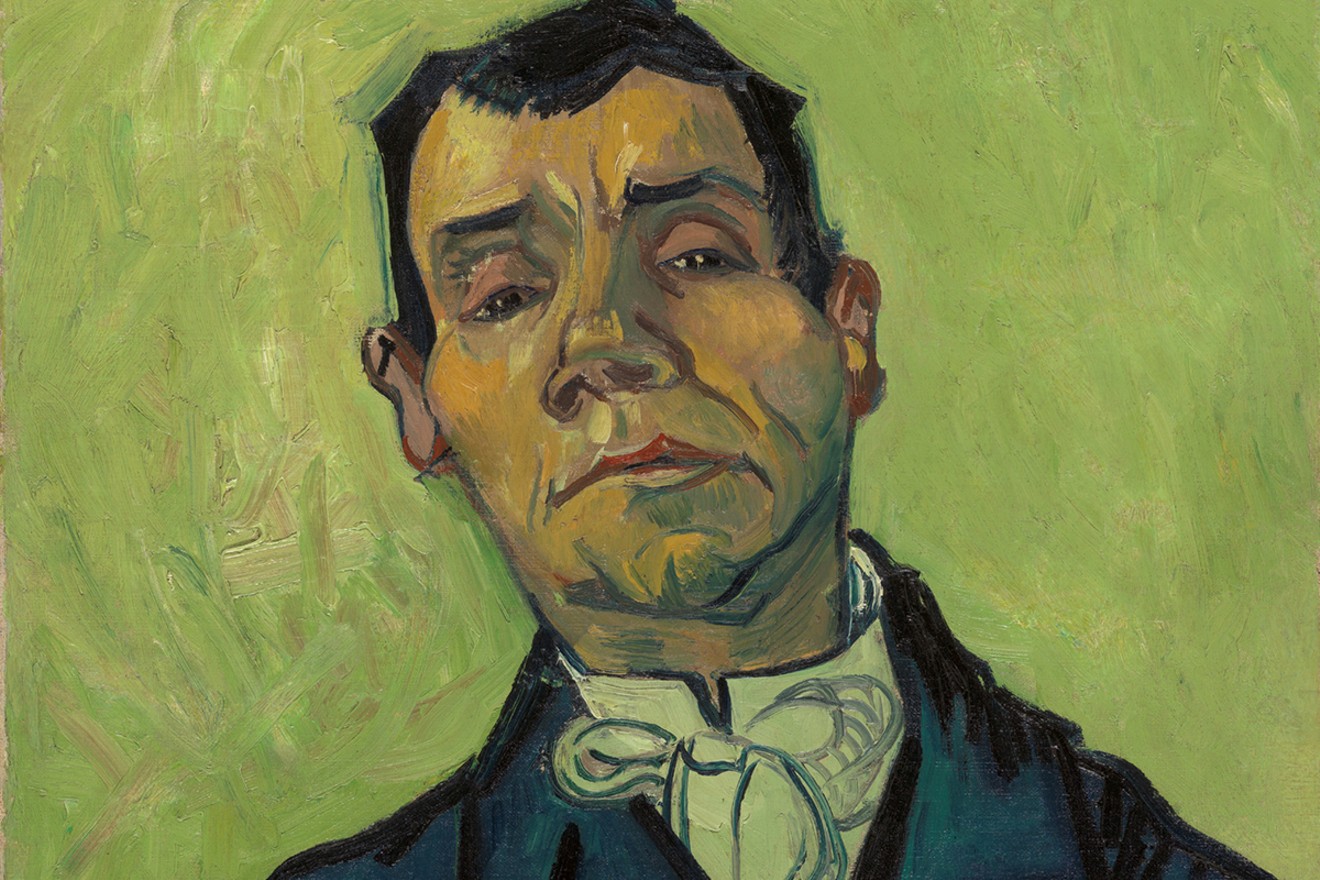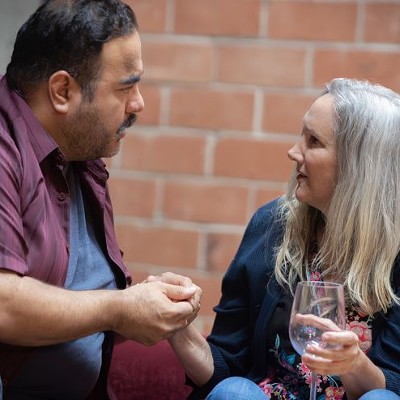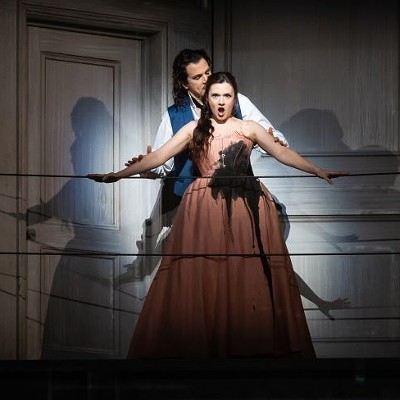Through June, Houstonians can dive into the artist's rise and fall at the Museum of Fine Arts, Houston in "Vincent van Gogh: His Life in Art," a major survey that brings together more than 50 masterworks.
But van Gogh's story is actually a tale of two brothers. We've all had difference-makers in our lives and, for Vincent, it was his younger brother Theo. From his teens until early adulthood, Vincent floundered around trying to figure out what he wanted to do when he grew up: apprentice to art dealers, teacher, book seller, preacher, or missionary.
Until Theo, the more grounded of the two brothers, sat Vincent down and said, "You have to decide." But once Vincent made the decision that he was going to be an artist, it was as if the switch had been flipped.
"His learning curve was almost vertical," said David Bomford, MFAH's Audrey Jones Beck Curator of European Art, and Chief of Conservation, in a members' preview of the exhibit."His learning curve was almost vertical." — David Bomford.
tweet this
Vincent, whose drawings up until then had been rough and raw, attended classes, studied with other artists, and quickly mastered the art of drawing. He was always influenced by his surroundings and his first paintings from his time in the Netherlands were dark, depicting the peasants with brutal, almost grotesque faces.
Vincent often stayed with his parents or brother, and always was on the dole from Theo, who had carved out a successful career as an art dealer. Later in Paris, through his brother's gallery, Vincent met Degas, Seurat and other French artists. It was here that his paintings became infused with color and brightness. Later, moving to the south of France, he invoked the kingdom of light. Through it all Vincent sent hundreds of letters to his brother, with sketches of his works in progress, and more than 800 of Vincent's letters have been fully annotated and preserved at vangoghletters.org.
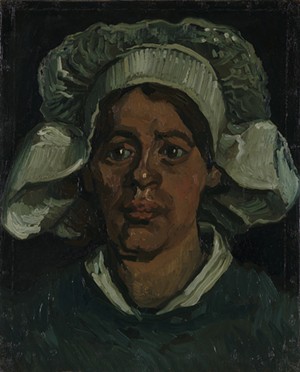
Vincent van Gogh, Head of a Woman Wearing a White Cap, 1884–1885.
© Photo by Rik Klein Gotink, copyright Kröller Müller Museum
Houston is the only venue for this major survey and viewing the works in print or online can't do justice; how many of us will be able to travel to the museums of Amsterdam, Otterlo and Paris to view the paintings? In person we can see the thick applications of oil paint, how his brush strokes evolved to small dots and then strokes, and how van Gogh's artistic swings moved from darkness to light and eventual madness.
Everybody will have favorites within the exhibit. I kept returning to The Old Church Tower at Nuenen (“The Peasants’ Churchyard”), where his father was buried; the side by side oil and chalk depictions of The Hill of Montmartre (the drawing was once thought to be a copy); the View of Saintes Maries de la Mer (with the rows of purple grapevine plants leading to a vanishing point); and the drawing Café Terrace on the Place du Forum (with a photo of the same scene painted at night).
By now everybody has heard that, in Vincent's final years, he began to suffer from bouts of anxiety and madness. In a row with his studio roommate Gauguin, he cut off part of his ear and presented it a brothel maid, causing Gauguin to flee the Yellow House forever. And how in 1889 Vincent voluntarily checked himself into a psychiatric hospital in Saint-Rémy-de-Provence. Vincent painted The Garden of the Asylum at Saint Rémy from that hospital in May of 1889; the oil is on view in this exhibit and the light literally sparkles from the canvas.
A little more than a year later, Vincent's relationship with Theo took one final turn. The artist, who had never achieved commercial success during his lifetime and always depended on his brother's generosity, grew fearful that Theo — who now had a family — would no longer be able to support him. Riddled with sadness, loneliness and uncertainty, Vincent shot himself in a wheat field and died two days later.
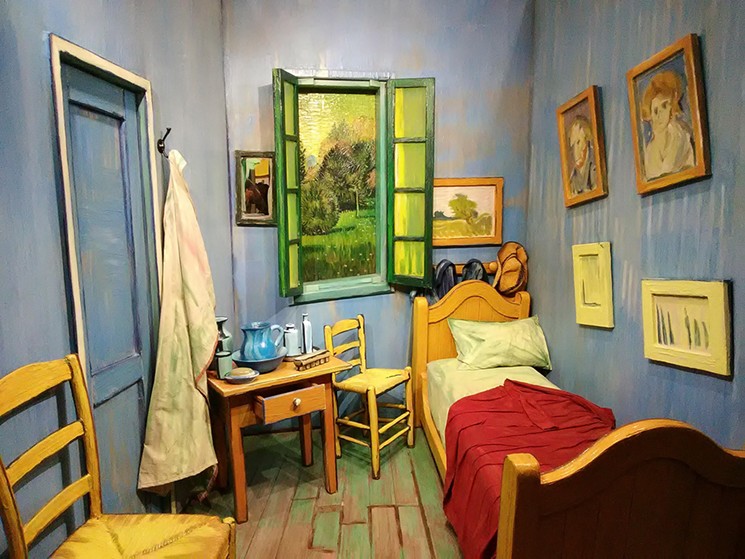
Have your picture taken in this forced perspective vignette, then continue energizing your social media feed with all the other photo ops in Van Gogh Up Close.
Photo by Susie Tommaney
Van Gogh Up Close
Visitors of all ages should not overlook the Van Gogh Up Close immersive exhibit. Anybody entering the space will feel a sudden jolt of that creative energy. It has forced perspective picture stations, photo opportunities where viewers can stand (or place their faces) within the scenes of famous paintings, replicas of the artist studio, portrait marker boards and, for the younger set, buttons to push and cartoons to watch. Adults of all ages will find themselves enthusiastically seated at a coloring table, and a portrait wall has spaces for visitors to insert their own self-drawn portraits. An electronic version of Starry Night exists here, where a touch of the finger will make the sky rotate or branches grow on the tree; while in the corner guests can don an apron and become immersed in a Parisian cafe.
"Vincent van Gogh: His Life in Art" is a major collaboration with the Van Gogh Museum, Amsterdam; and the Kröller-Müller Museum, Otterlo; which, together, hold the largest collections in the world of Van Gogh’s work. They each lent pieces to the MFAH for this exhibit. Significant works also traveled from Musée d’Orsay, Paris; Wallraf– Richartz Museum, Cologne; the Virginia Museum of Fine Arts, Richmond; Art Institute of Chicago; the Dallas Museum of Art; McNay Art Museum, San Antonio; and private collections.
"Vincent van Gogh: His Life in Art" continues through June 27 at 10 a.m. to 5 p.m. Tuesdays and Wednesdays, 10 a.m. to 9 p.m. Thursdays, 10 a.m. to 7 p.m. Fridays and Saturdays, 12:15 to 7 p.m. Sundays at the Museum of Fine Arts, Houston, Audrey Jones Beck Building, 5601 Main. For information, call 713-639-7300 or visit mfah.org/exhibitions/vincent-van-gogh-his-life-in-art. Free to $25.
Information about related events can be found here.

